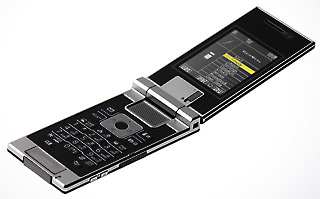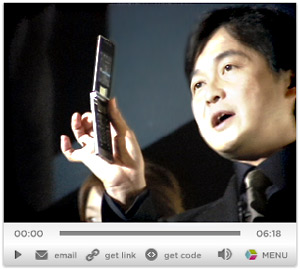DoCoMo Introduces 703i Series with Ten New 3G Handsets
 DoCoMo today announced the development of new 3G FOMA handsets – the 703i-series plus the D800iDS and SO903iTV. The 703i-series consists of eight models: N703i, P703i, D703i, F703i, N703iD, P703i, SH703i and SO703i. Most of the models are extra slim, with the N703i (image at right) and P703i being the thinnest 3G clamshell handsets in the world, at 11.4mm each, as of 15 January 2007 (and according to the company).
DoCoMo today announced the development of new 3G FOMA handsets – the 703i-series plus the D800iDS and SO903iTV. The 703i-series consists of eight models: N703i, P703i, D703i, F703i, N703iD, P703i, SH703i and SO703i. Most of the models are extra slim, with the N703i (image at right) and P703i being the thinnest 3G clamshell handsets in the world, at 11.4mm each, as of 15 January 2007 (and according to the company).
Our Wireless Watch Japan Web Video Triple Play article posted 10 November has a quick shot of Natsuno-san with these new extra-slim handsets.
The new 703i-series handsets made by NEC, Panasonic, Mitsubishi, Sharp, Fujitsu and Sony Ericsson have features ranging from full-track music, Mega Appli gaming and DCMX mobile commerce to document viewer and full mobile web browser. A couple of interesting design notes; Fujitsu’s F703i model is water-proof and claims to be completely safe in the shower while Mitsubishi’s D703i is Japan’s thinnest candybar-style cellphone available, at 9.9mm thick.
DoCoMo also unveiled the SO903iTV handset equipped with a high-resolution LCD using BRAVIA technology and high-quality audio for viewing “One-segment” (1 Seg) terrestrial digital TV broadcasts. In addition the company announced the D800iDS [.jpg image], which according to the press materials, is a world-first cellphone with two full screens – a conventional upper screen and a touch-screen instead of the traditional lower keypad. The N703iD will be marketed on 26 January. The other 703i-series models and D800iDS are planned to be sold in February, while the SO903iTV is scheduled to be launched in June.
We have images with full details after the jump.


 NTT DoCoMo, Inc. and its eight regional subsidiaries today announced 14 new 3G FOMA handsets, including the 903i-series, the ‘SIMPURE’ series and N902iL. All 11 new 903i handsets provide a wide range of entertainment functions, said the company. They are equipped for DoCoMo’s Chaku-Uta Full full-track music-downloading service. Five models can play tracks transferred from PCs that were used to download music from sites such as Napster Japan, which offers unlimited access to approximately 1.5 million downloadable tracks for a flat rate. HSDPA-capable models work with the Music Channel service, which enables up to two music programs to be downloaded automatically during the night, and the expanded i-motion video clip for downloading up to 10MB files. All models are compatible with Mega i-appli rich applications, and some are also equipped for “One-segment” digital terrestrial broadcasting.
NTT DoCoMo, Inc. and its eight regional subsidiaries today announced 14 new 3G FOMA handsets, including the 903i-series, the ‘SIMPURE’ series and N902iL. All 11 new 903i handsets provide a wide range of entertainment functions, said the company. They are equipped for DoCoMo’s Chaku-Uta Full full-track music-downloading service. Five models can play tracks transferred from PCs that were used to download music from sites such as Napster Japan, which offers unlimited access to approximately 1.5 million downloadable tracks for a flat rate. HSDPA-capable models work with the Music Channel service, which enables up to two music programs to be downloaded automatically during the night, and the expanded i-motion video clip for downloading up to 10MB files. All models are compatible with Mega i-appli rich applications, and some are also equipped for “One-segment” digital terrestrial broadcasting. In a deal that puts a new spin on mobile music promotion in the Japanese market, DoCoMo announced a partnership with Tower Records Japan opting to buy 42 percent of the music retailer for 12.8 billion yen ($109 million). Scheduled to go through by late November, the deal will make DoCoMo Tower’s single largest shareholder. The music retailer operates 78 Tower Records stores and 31 Wave music outlets. Tower’s motto in Japan is "The Best Place to Find Music" but will DoCoMo find it the best place to create musical revenue?
In a deal that puts a new spin on mobile music promotion in the Japanese market, DoCoMo announced a partnership with Tower Records Japan opting to buy 42 percent of the music retailer for 12.8 billion yen ($109 million). Scheduled to go through by late November, the deal will make DoCoMo Tower’s single largest shareholder. The music retailer operates 78 Tower Records stores and 31 Wave music outlets. Tower’s motto in Japan is "The Best Place to Find Music" but will DoCoMo find it the best place to create musical revenue?  The recent guest article,
The recent guest article,